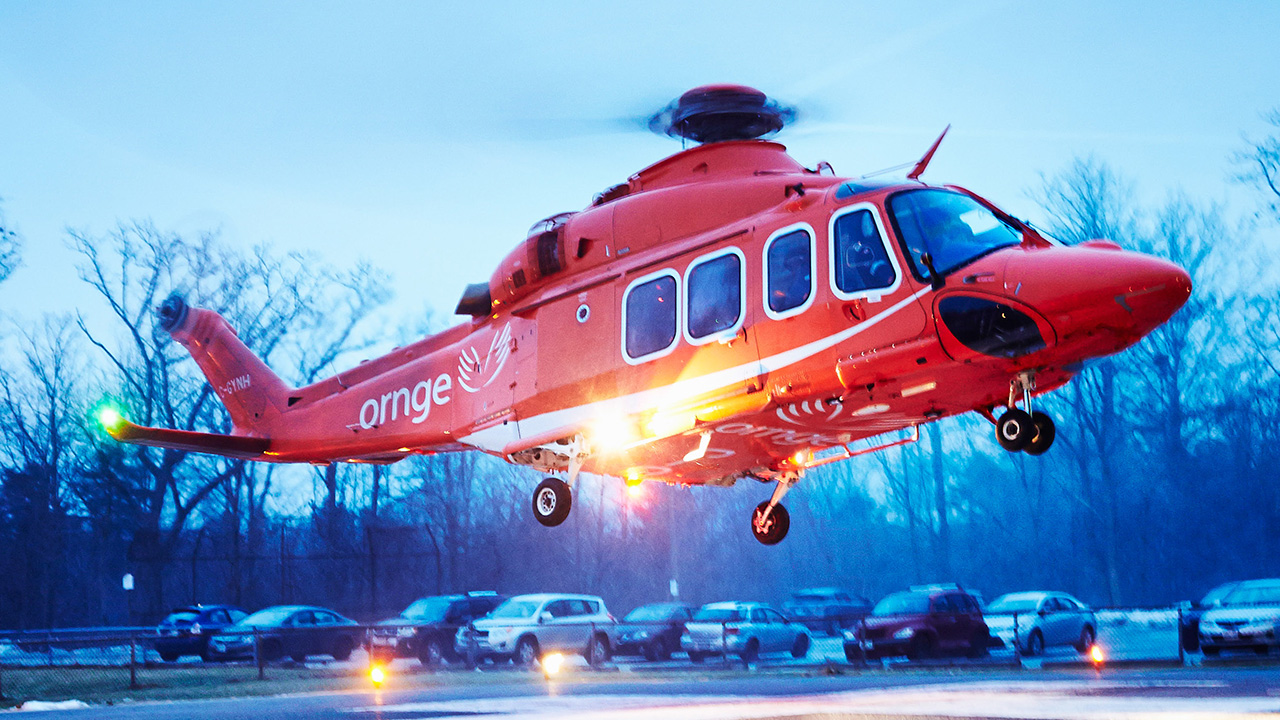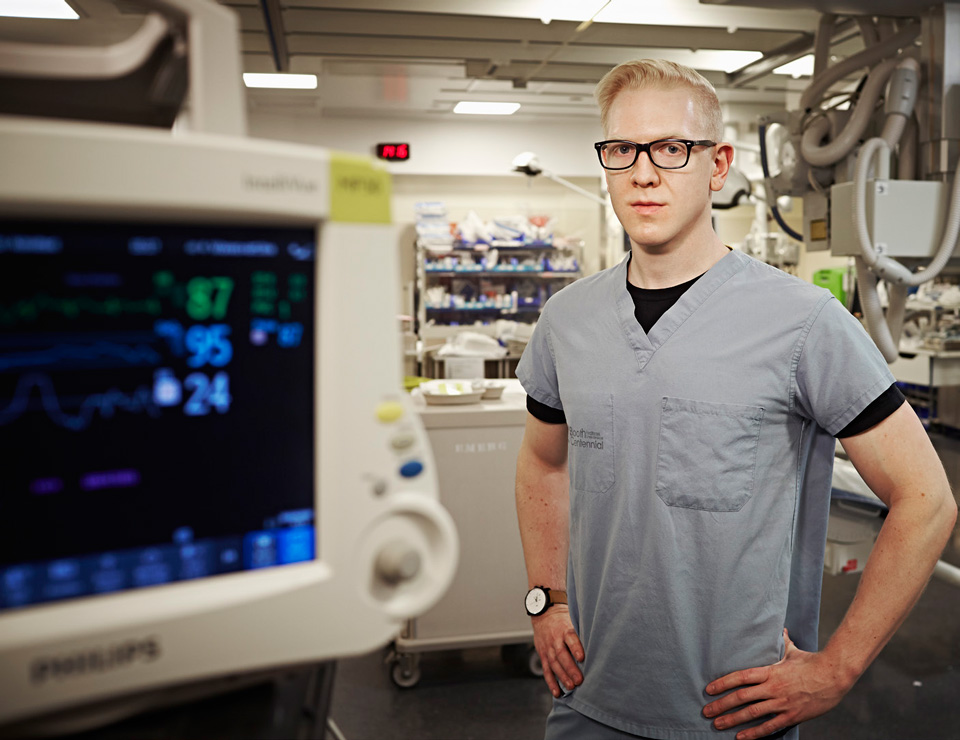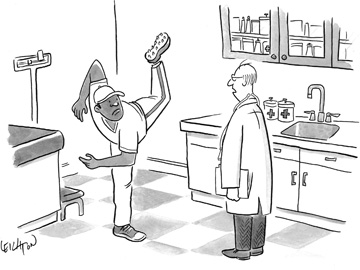You only get one shot

When it comes to transporting a severely injured patient to hospital, there are no second chances
June 12, 2017

An air ambulance lands at Sunnybrook with a trauma patient on board.
The adage “time is of the essence” is true for many areas of medicine but it is arguably most germane in trauma. Trauma care often focuses on what happens when a patient arrives at the hospital—blood transfusions, CT scans, surgeries—but it actually begins much earlier. The clock starts ticking the moment a person is injured. How long it takes for paramedics to reach them, what procedures are done at the scene or en route, how quickly they can be transported to a hospital that is capable of dealing with their injuries—these are all prehospital factors that directly affect a patient’s outcome.
The past decade has seen a dramatic shift in prehospital trauma care. “We used to believe that many procedures ought to be done in critically injured patients right then and there,” says Dr. Richard Verbeek, an emergency physician and head of the base hospital program at Sunnybrook. This approach, referred to as “stay and play,” has paramedics perform procedures such as intubations and starting an IV line to stabilize the patient at the scene. “In the last 10 years, we’ve done a total about-face,” he says. “Now we say to paramedics, ‘we don’t want you to spend time doing these things at the scene. We want you to safely get them in the back of the ambulance and do all of your critical interventions on your way to the hospital.’” The switch from “stay and play” to “scoop and run” highlights the recognition that for severely injured patients, the earlier they arrive at a trauma centre, the better their outcomes.
Speed, however, is not the whole story. As one group of Sunnybrook researchers looks for ways to shorten the time from scene to hospital, yet another is trying to integrate potentially life-improving interventions into existing prehospital strategies. Their common goal: to give each patient the best chance of surviving and returning to his pre-injury life.
“There are a lot of moving parts to get patients to Sunnybrook in a timely fashion,” says Dr. Brodie Nolan, a fifth-year emergency medicine resident at the University of Toronto. As one of only two adult Level 1 trauma centres in the Greater Toronto Area (St. Michael’s Hospital is the other), Sunnybrook receives some of the most severely injured patients from the farthest locations. “Because there are so many moving pieces, I think there are a lot of opportunities to find ways to either improve or expedite care,” says Nolan.
One area where he identified potential for improvement is aeromedical transport. In Ontario air ambulance services are provided by Ornge, a provincially run, nonprofit organization that operates the largest fleet of air and critical care land ambulances in Canada. Ornge helicopters pick up a patient directly from where he is injured, in what is known as a scene call, or from a non-trauma centre where the patient was initially brought.

Dr. Brodie Nolan helped lead a study quantifying why patient transport was delayed.
Using trauma registry data from Sunnybrook and St. Michael’s Hospital, Nolan and his co-authors examined the records of 911 patients who were brought to Level 1 trauma centres by helicopter between 2012 and 2014. Between 62% and 74% of the transportation delays they identified were caused by modifiable factors, meaning that these wait times can be reduced or eliminated. Most setbacks occurred either at the scene or sending hospital. For example, in nearly one-quarter of the cases, air transport was forced to wait because the sending physician was doing a procedure that might not be critically important to survival. Doctors ordering imaging like CT scans was the cause of additional delays. Others happened en route—the weather was poor, a patient went into cardiac arrest—or at the receiving end; for example, the aircrew had to wait for a land crew to escort the patient from the helipad to the hospital, or for the trauma team to assemble.
The study, the first of its kind in Canada, also found that there was a group of patients for whom the wait time was extended because the initial air ambulance call while en route was cancelled and then dispatched again later. “It would have been better for the patient and for the system if we had the opportunity to transport the patient when first called; with severely injured patients, there is often only one chance to do it right,” says study co-author Dr. Homer Tien, an associate scientist in the Tory Trauma Research Program at Sunnybrook Research Institute (SRI) and trauma surgeon in Sunnybrook's trauma centre. The registries didn’t have the level of detail to say why this happened, but it’s clearly an area for targeted improvement. “If we can figure out how to avoid those cancellations, particularly the ones that get called back later, I expect that there would be better outcomes and system savings,” says Tien.
Nolan points out that while their study was not designed to detect differences in outcomes caused by transportation delays, evidence from other published research shows that the earlier these patients can get to a trauma centre, the better their recoveries. “Bringing patients to the trauma centre as quickly and as efficiently as possible is usually in their best interests,” he says.
As chief medical officer for Ornge, Tien is particularly interested in how the province’s aeromedical resources can be used more effectively, given that only 7% of Ornge dispatches are for trauma scene calls. “The helicopters aren’t just for trauma,” he says. “If we’re called away to a trauma scene—these calls are deemed to have the highest priority—that’s another case [somewhere else] that we can’t go to.” These other cases are the interfacility transfers that comprise most of Ornge’s air ambulance dispatches. In such a move a patient is relocated by land or air to a hospital that is better suited to deal with his medical needs.
Tien recently collaborated with Dr. Avery Nathens, director of the TECC Research Program at SRI, and Sunnybrook’s surgeon-in-chief and medical director of trauma, to assess the strategies hospitals use to transfer trauma patients from one facility to another. “We know that patients cared for at a trauma centre like Sunnybrook have a lower mortality rate and a greater return to their pre-injury level of function. They clearly have better outcomes than patients cared for in non-trauma centres,” says Nathens. “Patients are injured anywhere in the province—and not necessarily close to a trauma centre. How do we ensure access to care for those patients so they have a higher probability of good outcomes?”
Using a novel approach that combined the province’s trauma registry data with maps showing routes and distances, the researchers were able to follow 7,702 severely injured patients to their various destinations, including community hospitals and trauma centres. They also probed which hospitals used an optimal transfer strategy by choosing a destination and mode of transport with the shortest overall travel time, and how consistent facilities were in selecting their strategies.
The researchers found that 30% of severely injured patients across the region were transported using an ideal strategy. Only 12% of sending hospitals transferred more than 90% of their trauma patients optimally. “We found that decisions about how best to transport a patient and their transport destination were more or less random,” says Nathens, who is a professor of surgery at U of T. “There are no guidelines that the emergency doctors have at their disposal to help them make decisions about who they should be calling, land versus air, and what would be the right hospital to send patients to.”

First responders transfer a patient from air ambulance to land ambulance at Sunnybrook. They play a critical role in conducting research to advance prehospital care.
While their selections didn’t always lead to the shortest transfer times, hospitals were more consistent in which receiving trauma centre and mode of transportation they chose. Most transfers occurred between a community hospital and a specific trauma centre, suggesting there might be pre-existing relationships that can be capitalized upon to improve the quality of care and flow of patients through the system.
The results drove Nathens and Tien to develop and implement initiatives to improve the movement of severely injured patients from the referring hospital to a trauma centre. Much of their effort targets the regional trauma network, a hub-and-spoke model connecting trauma centres to community hospitals. “The trauma centre is viewed as the hub of a wheel, and the spokes are the different pathways by which the community hospitals refer their patients,” says Tien, who is also an associate professor in the department of surgery at U of T. “As the hub, we have a responsibility to meet with our referring centres and discuss ways of improving care in the system.”
For example, in the air ambulance study, Nolan and Tien found that a cause of delay was physicians ordering procedures like CT scans. These time-consuming steps are often unnecessary because the receiving centre will perform its own tests if needed. To address this and other concerns, Nathens started issuing information back to community hospitals to provide feedback on how long it took hospitals to send patients to trauma centres. The goal is to streamline the transfer process by minimizing the number of interventions done at the sending facility and choosing the fastest mode of transportation for each case.
In a second project, Nathens launched a partnership between the trauma and base hospital programs at Sunnybrook to provide feedback to paramedics. “We’ve started issuing individual letters to paramedics about patients they bring in to Sunnybrook,” says Verbeek. “The letter outlines what injuries were detected in the trauma unit here and the broad outcomes.” He notes that for most paramedics the details of trauma cases are often etched in their minds. Reports like these allow them to compare their perception of a patient’s injury to what was actually found and, Verbeek hopes, guide them to make a more informed decision about whether the next patient’s injuries are severe enough to warrant being taken to a trauma centre, or whether he can be well cared for at a community hospital.
First responders also play a vital role in conducting research to drive prehospital care forward. “Paramedics are doing an excellent job recruiting patients in the field under stressful and challenging situations,” says Dr. Barto Nascimento, an associate scientist in the TECC Research Program at SRI. He is one of the investigators in a study looking at a novel way to improve long-term neurologic outcomes in patients with moderate-to-severe traumatic brain injury (TBI).
“Trauma is the number one killer in young people, but among those that die, what do they die from?” asks Nascimento. “Half of trauma deaths are related to TBI.” In patients with TBI, the two most urgent concerns are getting enough oxygen to the brain and controlling cerebral bleeding. Tranexamic acid (TXA) helps to prevent further bleeding by maintaining the clots that form in damaged vessels to stop blood from leaking out. A previous in-hospital trial in trauma patients demonstrated that those who received TXA within the first hour after injury had a 13% lower mortality rate. “If you give TXA within three hours of injury, it’s beneficial,” says Nascimento. “If you give it after three hours, the hazard ratio goes in the other direction—that of harm.”

"Then don't do that."
In the current randomized controlled trial Nascimento and his colleagues at St. Michael’s Hospital have partnered with regional paramedics to determine if administering TXA in a prehospital setting, either at the scene or en route to hospital, can help patients with TBI make a better recovery. They will look not only at the drug’s effect on survival, but also its impact on neurological functioning six months after injury. Results from the study are expected later this year.
“It could change the way we resuscitate these patients in the field and in hospital,” says Nascimento. “If it does, then it’s going to change protocols. That’s going to be huge.”
Research Funding
Nascimento: American Heart Association, Canadian Institutes of Health Research (CIHR), Defense Research and Development Canada, Heart and Stroke Foundation of Canada, National Heart, Lung and Blood Institute, and U.S. Army Medical Research and Material Command. Nathens: CIHR and the De Souza Chair in Trauma Research. Verbeek: CIHR, National Institutes of Health and Ontario Centres of Excellence Program.



